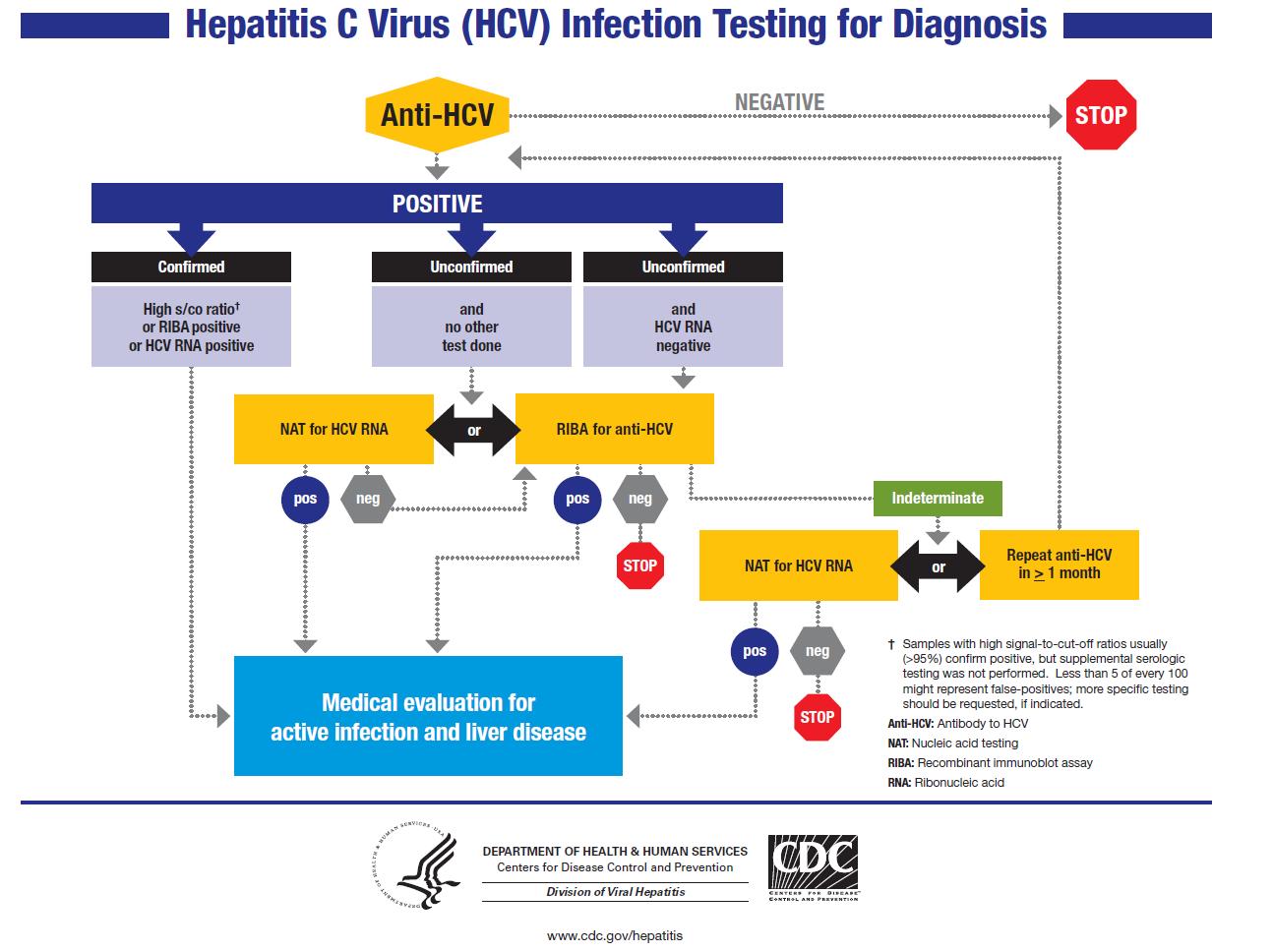Hepatitis C laboratory tests: Difference between revisions
Varun Kumar (talk | contribs) (Created page with "{{Hepatitis C}} {{CMG}}; '''Assistant Editor-In-Chief:''' Nina Axiotakis [mailto:naxiotak@oberlin.edu] == Diagnosis == The diagnosis of "hepatitis C" is rarely made during t...") |
Varun Kumar (talk | contribs) |
||
| Line 40: | Line 40: | ||
A single positive PCR test indicates infection with HCV. A single negative test does not prove that a person is not infected. Virus may be present in the blood and just not found by PCR. Also, a person infected in the past who has recovered may have a negative test. When hepatitis C is suspected and PCR is negative, PCR should be repeated. | A single positive PCR test indicates infection with HCV. A single negative test does not prove that a person is not infected. Virus may be present in the blood and just not found by PCR. Also, a person infected in the past who has recovered may have a negative test. When hepatitis C is suspected and PCR is negative, PCR should be repeated. | ||
[[File:HCV infection diagnosis.JPG]] | |||
==References== | ==References== | ||
Revision as of 21:27, 17 February 2012
|
Hepatitis C |
|
Diagnosis |
|
Treatment |
|
Hepatitis C laboratory tests On the Web |
|
American Roentgen Ray Society Images of Hepatitis C laboratory tests |
|
Risk calculators and risk factors for Hepatitis C laboratory tests |
Editor-In-Chief: C. Michael Gibson, M.S., M.D. [1]; Assistant Editor-In-Chief: Nina Axiotakis [2]
Diagnosis
The diagnosis of "hepatitis C" is rarely made during the acute phase of the disease because the majority of people infected experience no symptoms during this phase of the disease. Those who do experience acute phase symptoms are rarely ill enough to seek medical attention. The diagnosis of chronic phase hepatitis C is also challenging due to the absence or lack of specificity of symptoms until advanced liver disease develops, which may not occur until decades into the disease.
Chronic hepatitis C may be suspected on the basis of the medical history (particularly if there is any history of IV drug abuse or inhaled substance usage such as cocaine), a history of piercings or tattoos, unexplained symptoms, or abnormal liver enzymes or liver function tests found during routine blood testing. Occasionally, hepatitis C is diagnosed as a result of targeted screening such as blood donation (blood donors are screened for numerous blood-borne diseases including hepatitis C) or contact tracing.
Hepatitis C testing begins with serological blood tests used to detect antibodies to HCV. Anti-HCV antibodies can be detected in 80% of patients within 15 weeks after exposure, in >90% within 5 months after exposure, and in >97% by 6 months after exposure. Overall, HCV antibody tests have a strong positive predictive value for exposure to the hepatitis C virus, but may miss patients who have not yet developed antibodies (seroconversion), or have an insufficient level of antibodies to detect. While uncommon, a small minority of people infected with HCV never develop antibodies to the virus and therefore, never test positive using HCV antibody screening.
Anti-HCV antibodies indicate exposure to the virus, but cannot determine if ongoing infection is present. All persons with positive anti-HCV antibody tests must undergo additional testing for the presence of the hepatitis C virus itself to determine whether current infection is present. The presence of the virus is tested for using molecular nucleic acid testing methods such as polymerase chain reaction (PCR), transcription mediated amplification (TMA), or branched DNA (b-DNA). All HCV nucleic acid molecular tests have the capacity to detect not only whether the virus is present, but also to measure the amount of virus present in the blood (the HCV viral load). The HCV viral load is an important factor in determining the probability of response to interferon-based therapy, but does not indicate disease severity nor the likelihood of disease progression.
In people with confirmed HCV infection, genotype testing is generally recommended. There are six major genotypes of the hepatitis C virus, which are indicated numerically (e.g., genotype 1, genotype 2, etc.). HCV genotype testing is used to determine the required length and potential response to interferon-based therapy.
Laboratory Diagnosis
- HCV Enzyme-linked immunosorbent assay (ELISA)
- Positive within 4-10 weeks after infection
- False negatives can occur with HIV infection, chronic renal failure, cryos
- HCV RNA
- Polymerase chain reaction (PCR) highly sensitive for confirming viremia
- Predicts response to therapy but not risk of progression
There are several blood tests that can be done to determine if you have been infected with HCV. Your doctor may order just one or a combination of these tests. The following are the types of tests your doctor may order and the purpose for each:
a) Anti-HCV (antibody to HCV)
EIA (enzyme immunoassay) or CIA (enhanced chemiluminescence immunoassay) Test is usually done first. If positive, it should be confirmed
RIBA (recombinant immunoblot assay) A supplemental test used to confirm a positive EIA test
Anti-HCV does not tell whether the infection is new (acute), chronic (long-term) or is no longer present.
b) Qualitative tests to detect presence or absence of virus (HCV RNA)
c) Quantitative tests to detect amount (titer) of virus (HCV RNA)
A single positive PCR test indicates infection with HCV. A single negative test does not prove that a person is not infected. Virus may be present in the blood and just not found by PCR. Also, a person infected in the past who has recovered may have a negative test. When hepatitis C is suspected and PCR is negative, PCR should be repeated.
